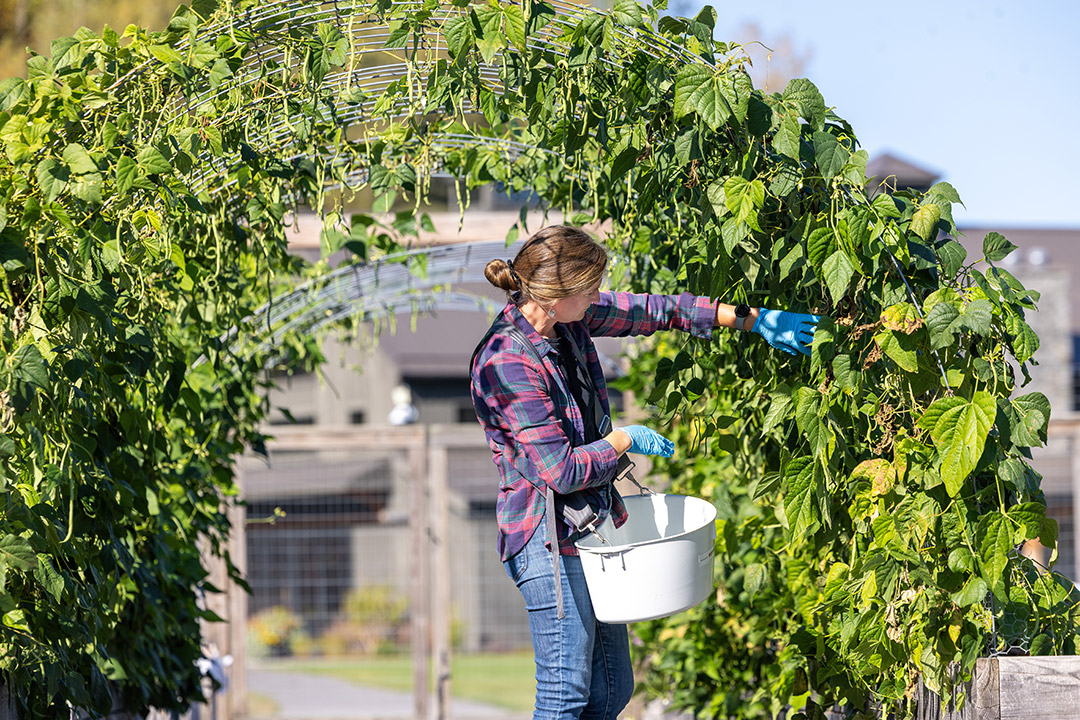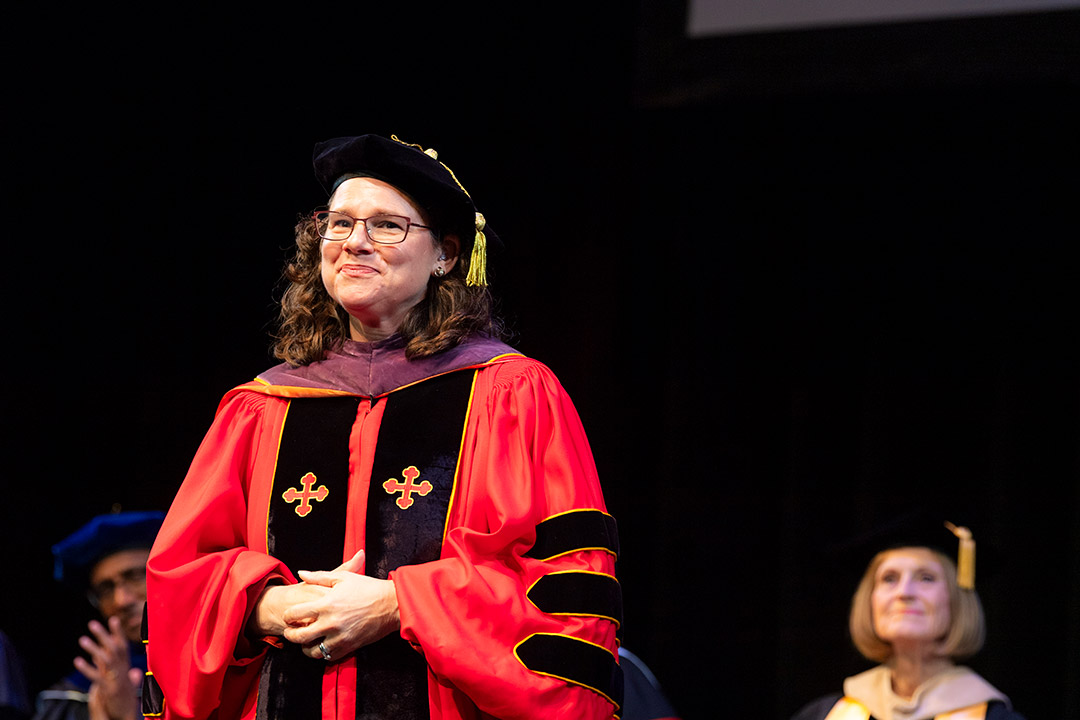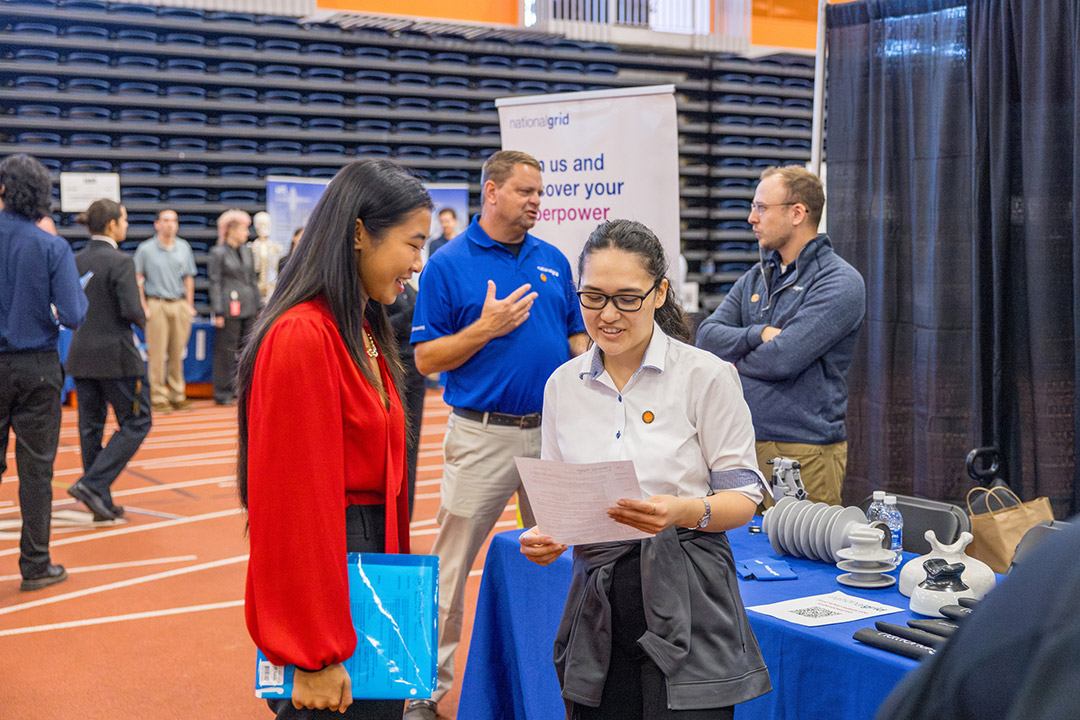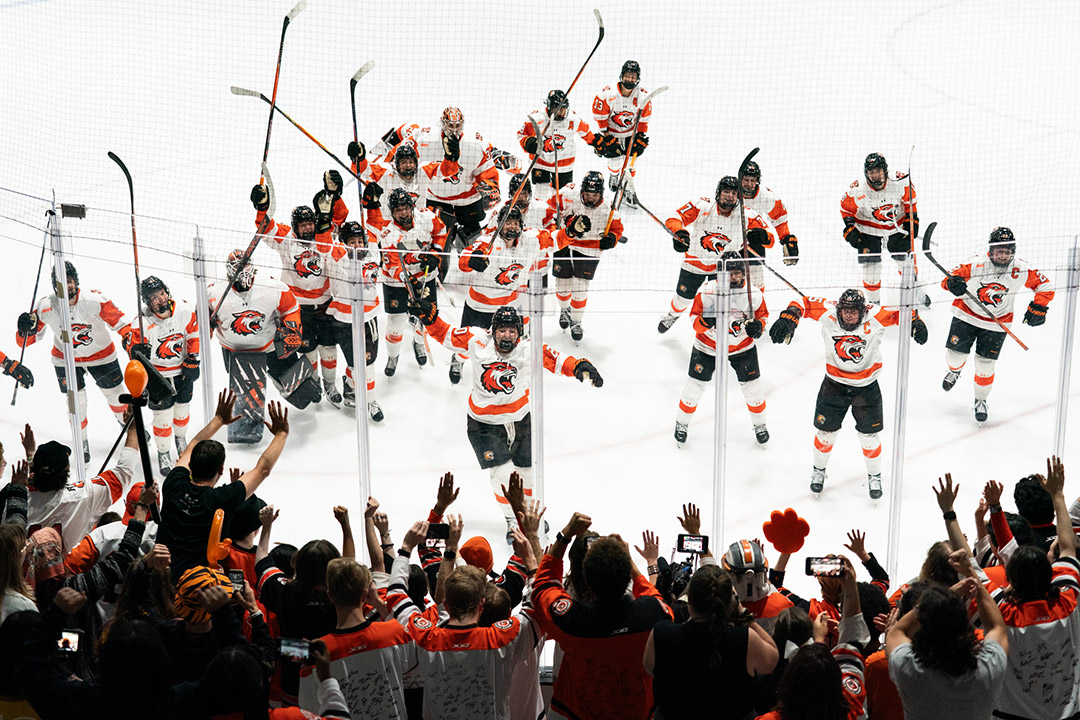Students use AI to aid United Nations in Ukrainian refugee response
Two RIT students are using artificial intelligence (AI) to better support refugees and reshape how humanitarian organizations make data-driven decisions.
Natalie Crowell and Olivia Croteau—who are both third-year humanities, computing, and design majors—are developing an AI tool that analyzes publicly available social media data, specifically from chat groups where refugees discuss needs related to housing, food, and other resources. For humanitarian organizations, this synthesized data can provide invaluable insights, at a low cost.
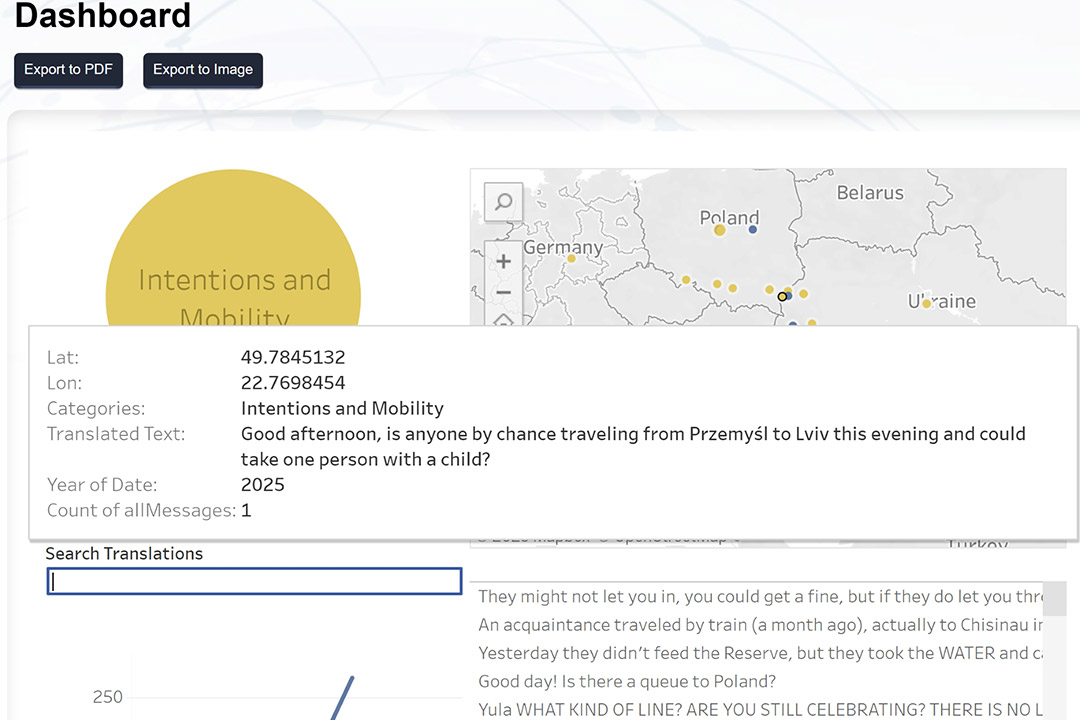
A prototype of the AI dashboard being created by RIT students. The tool can translate, categorize, and map data from the social media posts of Ukrainian refugees in Poland.
The students were hired to work on the project as a co-op. The tool that they create could help the United Nations Migration Agency, International Organization for Migration (IOM), improve its response to the ongoing refugee crisis in Poland. According to the United Nations, about 1 million Ukrainian refugees are now in neighboring Poland.
“The goal is to make AI tools as accessible as possible to the people running humanitarian aid,” said Croteau, who is a double major studying new media interactive development.
“We think that having a cheap way to collect and interact with data could be foundational to organizations like this,” added Crowell. “Especially at a time when so much funding is being cut.”
How it started
Crowell and Croteau met in a first-year Python coding class at RIT. They’ve been friends ever since.
While Crowell was taking a course last fall for her geographic information systems immersion, she learned about new research from her professor, Brian Tomaszewski.
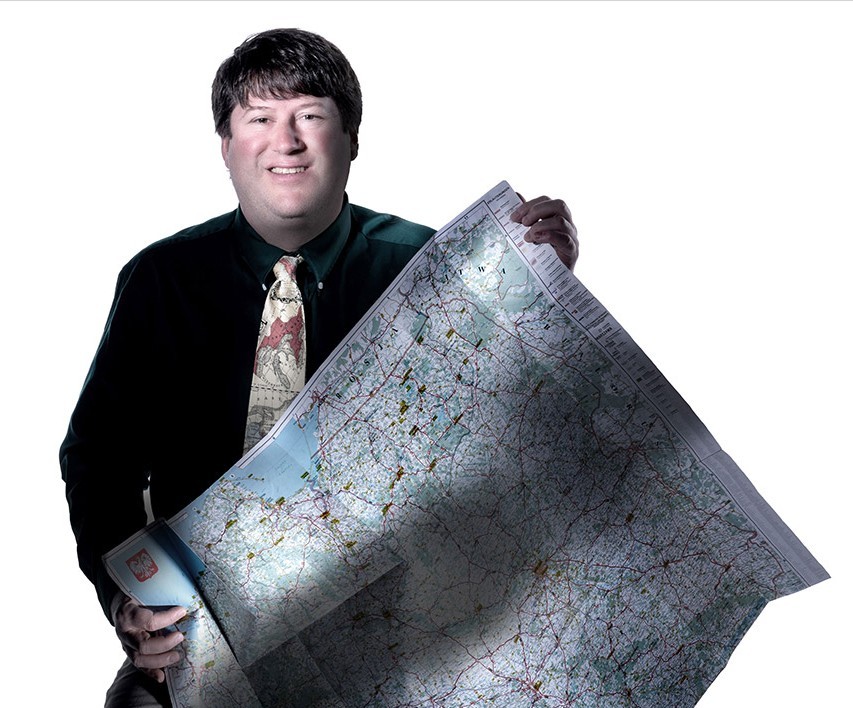
Carlos Ortiz
Brian Tomaszewski
Tomaszewski, a professor in RIT’s School of Interactive Games and Media, spent time researching and teaching in Poland as part of a 2023 Fulbright U.S. Scholar Award. He used large-language models to study the situation of forced displacement of Ukrainian refugees and sought feedback from IOM staff to publish a paper.
The professor was looking for students to continue work based on his research. When Crowell told Croteau about this, they brainstormed an idea, wrote the entire proposal for their tool in one morning, and presented it to Tomaszewski.
“Natalie and Olivia are just another example of the amazing students we have here, “said Tomaszewski. “They are directly on the front line of recent upheavals with the foreign assistance given by the United States, which in some sense is frustrating, but also a good learning experience at the beginning of their careers considering humanitarian work.”
How it works
The current prototype extracts discussions by Ukrainian refugees on the popular open-source messaging app Telegram.
Each day, thousands of people will contribute to group discussions about aid. While humanitarian workers do comb through Telegram messages, it can be difficult to read them all.
Crowell and Croteau are designing a tool that uses AI to assign discussions into categories that IOM has already identified. The students are taking a natural language processing (NLP) vector approach to transform sentences into a series of numbers, which then get categorized based on similarity. Some of these categories include mobility, access to education, accommodations to housing, and protection.
The tool includes a fine-tuned NLP model that the students are training to detect locational references. These references are then geocoded with the latitude and longitude. The developers are also implementing AI to analyze photos and videos and translate messages into other languages.
“Humanitarian aid workers typically have to deliver reports, with graphs and visual data,” said Croteau, who is from Ballston Lake, N.Y. “Having interactive data is a great way to get the message across.”
The tool will include a dashboard with AI-created visualizations. Using geocoding, the tool can map data to show where resources are most needed.
Additionally, the students will add confidence scores to the dashboard. It can also generate an AI synopsis of the biggest trends and most common questions of the day.
“What’s great is that this data is coming directly from the people and what the people need,” said Crowell, who is from Pasadena, Calif. “As humanitarian researchers, listing the source of data is essential.”
How it helps
The RIT student researchers are working with Harley Emery, data and research officer with IOM Poland, to fine-tune their tool. Emery shared her personal thoughts on the project, which do not reflect the views of the organization.
Emery explained that humanitarian organizations rely heavily on data to identify the locations and needs of vulnerable migrants and refugees. Without timely, accurate data, it can be difficult to identify target populations for humanitarian interventions, she said.
“While IOM has many of its own methods for gathering and analyzing data on displaced people, I have yet to see a ready-to-use tool that can analyze public social media data on the fly, as this project aims to,” said Emery. “I see a tool like Natalie and Olivia’s being used as a way to rapidly analyze and summarize public discourse online—at low-cost and requiring very little time—to gain initial insights which could then be explored and verified further as needed.”
While the political environment and recent funding cuts pose challenges, the students remain passionate about their work. They see a scalability factor with their project. This low-cost, high-impact tool could be applied to other global crises.
Croteau and Crowell plan to write a paper about their project for the IEEE Global Humanitarian Conference.
“It’s invigorating to use AI to make meaningful impact,” said Croteau. “This is about more than just tech—it’s about being part of the solution.”
Latest All News
- Tait Preserve garden yields produce for campus eateriesStudents dining at Gracie’s and Brick City Café might not know it, but some of the vegetables they’re eating may have been harvested that very same day on RIT property. In its fourth year of production with a “farm to table” spirit, a 120-foot by 60-foot garden at the university’s Tait Preserve in Penfield, N.Y., yields about 3,000 pounds of vegetables and herbs per year, used for healthy meals in dining areas and at special events served by RIT Catering. The raised-bed garden was designed to accommodate high density and high production to provide fresh produce to RIT. It yields green beans, Swiss chard, green onions, spinach, tomatoes, squash, kale, cherry tomatoes, culinary pumpkins, beets, eggplant, cilantro, fingerling potatoes, three types of peppers, and a variety of herbs. Carlos Ortiz/RIT Meghan Gilbert, senior gardens and grounds specialist at RIT’s Tait Preserve, harvests beets to be used at Gracie’s and RIT Catering. “Sometimes RIT Dining has had a hard time sourcing specialty ingredients such as habaneros and scotch bonnet peppers on a consistent basis,” said Meghan Gilbert, the preserve’s senior gardens and grounds specialist. Some of those ingredients are necessary for Jamaican and Haitian dishes, which have been added as occasional dining options to accommodate requests from students. “We’re able to fill a niche by growing items they cannot source elsewhere,” she said. The preserve is a former quarry site, with very sandy soil not suited for vegetable growing. So, the garden beds are raised 30 inches off the ground, with topsoil and compost used to sustain the plants. “We space plants closely for high-volume output,” Gilbert said. “We try to provide RIT Dining with as much fresh produce as possible during our growing season.” Harvesting can be done as late as December, especially for kale and other cold-hardy crops, she said. Student employees pick the mature vegetables and herbs and place them in produce bins for delivery to RIT. Carlos Ortiz/RIT A hydroponic system at Tait Preserve is being used to grow watercress for use at Gracie’s and RIT Catering as ingredients, in salad bars, side dishes, or as garnishes. “Having this garden provides a huge advantage in the quality and freshness of the produce,” Gilbert says. “The shelf life, taste, and nutritional value is much better when you can serve it quickly after the harvest, in our case, sometimes as soon as the same day. You’re not getting that from any other supplier. It’s hyper local. It’s literally grown 15 minutes away from campus and delivered with an electric car.” In addition to the garden, the grounds also feature an orchard with about 600 trees of 11 different apple varieties that were planted in 2022 and could be ready with a viable crop next year. Most will be used for eating, and some will be used for baking or garnishing. Gilbert meets with the staff from RIT Dining every winter to see if there’s anything new they’d like her to try to grow. She’s already experimenting with microgreens and is using a hydroponic system to grow watercress, which she said was deemed the most nutrient-dense vegetable by the Centers for Disease Control. RIT has set a goal to serve more plant-based food. Gilbert said culinary mushrooms could help with that effort, with future production plans in the works. “It’s a great little niche for us to try to figure out how we can play a part in this goal,” she said.
- RIT Big Shot team blitzes Highmark StadiumRochester Institute of Technology commemorated the Buffalo Bills’ final season at Highmark Stadium on Oct. 11 with a one-of-a-kind photograph that will be displayed in the new stadium when it opens next year. The 360-degree, extended exposure nighttime photo was created during the 37th RIT Big Shot, an annual event that has highlighted Croatia’s medieval Old Town in Dubrovnik, Cowboys Stadium, Churchill Downs, The Alamo, and dozens of locations in the United States. The project began in 1987 to teach RIT students how to solve complicated problems with simple tools and teamwork. On Oct. 11, thousands of students and community volunteers used flashlights and other light sources to “paint” the 52-year-old stadium with light, while the Big Shot camera team captured the image. Big Shot team This year’s Big Shot marked the first year the team created a full 360-degree panoramic image of a subject. The above image will be displayed in the new stadium when it opens next year. Eric Kunsman, co-coordinator of the Big Shot and assistant professor at RIT’s National Technical Institute for the Deaf, said the support from the regional community made this one of the biggest Big Shot events in recent years. “Whether people came out because they love photography, the Bills, or both, the fact that we had thousands of people working together to create one photo is a powerful experience,” he said. “When people see the photo online or in the new stadium, they can point to where they stood or where they pointed their flashlight to help create the image. It’s an incredible memory for everyone involved.” This year marked the first time that the Big Shot team captured a full 360-degree panoramic image of a subject. In addition to the panoramic photograph, the team captured six additional photographs to ensure every inch of the stadium was documented. Rebecca Villagracia, a fourth-year photojournalism student from Orange County, Calif., has set her sights on a career in professional sports photography after graduation. Participating in the Big Shot was both a fun way to contribute to Buffalo Bills’ history and a learning opportunity. Big Shot team Over 6,000 volunteers came out to help create the Big Shot photograph this year. Each “brushstroke” of light in the image above was created by Big Shot volunteers. Villagracia operated one of the six additional cameras placed at the top of the stadium, along with one of the Buffalo Bills’ photography interns. “This was kind of a once-in-a-lifetime type of opportunity,” she said. “I’ve photographed in baseball and basketball stadiums, but a football stadium is so much larger. I also don’t do a lot of nighttime photography where you’re just keeping the camera shutter open for a minute or two, so incorporating that into an aspect of sports photography with the unique venue was definitely something cool to learn.” Dan Hughes, Big Shot co-coordinator and lecturer in the School of Photographic Arts and Sciences in RIT’s College of Art and Design, said creating opportunities like this for students and the RIT photography community is always top-of-mind. “There is no better way to learn than by working alongside someone in the same position that a student might aspire to be in after they graduate,” said Hughes. “We’re grateful that the Buffalo Bills photography team helped make this possible for them.” Big Shot No. 37 was made possible by partnering with the Buffalo Bills and CEPA Gallery. The event is sponsored and organized by the School of Photographic Arts and Sciences in RIT’s College of Art and Design, NTID’s Department of Visual Communication Studies, Nikon, and the Estate of Henry D. Navas ’74 (MBA), ’77 MS (accounting) and Deborah L. Robbins. Other sponsors include Mccrae Industries, Hill + Valley Creative, and Scott’s Rochester Photo Supply. The final panoramic photograph will be available to purchase on the Big Shot website after Oct. 20. All six additional images will be posted to the website in the coming days. To keep up with the Big Shot community, go to the Big Shot Facebook page.
- Caroline Solomon installed as first woman president of RIT’s National Technical Institute for the DeafRethinking how to support students, leading and driving innovation, and investing in transformative teaching and impactful research are some of the focus areas of Caroline Solomon, who was installed as the first woman president of RIT’s National Technical Institute for the Deaf on Oct. 10. In her inauguration speech, Solomon, who also serves as vice president of RIT, encouraged the campus community to help “prepare students for a world that needs their voices, their leadership, their moral compasses, their ability to be agile and adapt and innovate.” Reflecting on her career and her path to leadership, Solomon talked about what her appointment means to the community. “It’s about every student who wonders if they can lead in spaces where they have never seen themselves reflected,” she said. “Your voice—whether it’s signed, spoken, written, or felt—matters deeply. Your perspective is needed. And your future is limitless.” Matthew Sluka/RIT Caroline Solomon is joined by past leaders of RIT’s National Technical Institute for the Deaf, from left to right, T. Alan Hurwitz, Robert Davila, and Gerry Buckley. Speakers included Bill Sanders, RIT president; Susan Holliday, vice chair, RIT Board of Trustees; Prabu David, RIT provost and senior vice president for Academic Affairs; Larry Buckley, senior associate dean, College of Science; Patricia Glibert, professor at the University of Maryland Center for Environmental Science’s Horn Point Laboratory; and Emma Kane, a fourth-year public policy and business administration student at RIT. “Dr. Solomon’s focus on research and teaching the STEM disciplines and her dedication to sharing her enthusiasm and excitement for the sciences with her students are what drives her and has made her such a success in classrooms, labs, on research vessels, and in remote regions throughout the world,” said Sanders. “I couldn’t be more thrilled to welcome you to RIT and to support you in your leadership of NTID.” The keynote address was delivered by Carol Padden, the Sanford I. Berman Endowed Chair, Distinguished Professor, and dean of the School of Social Sciences at the University of California San Diego. Padden, one of Solomon’s early mentors, talked about first impressions and what it takes to lead an institution like NTID. “I had the distinct impression that you were a person of quality and integrity,” said Padden of Solomon. “You’ve charted a solid path forward from these early years to this crowning achievement. The admiration comes from how much we identify with you, as a woman, as a deaf woman, a scientist, and a humane leader, all in one. Our country needs committed leaders who will work alongside others to plan a future for our universities in this crucial time in American history.” Solomon, who began her tenure at NTID on Aug. 18, joined the faculty of Gallaudet University as a biology instructor in 2000 and rose to the rank of professor in 2011. She received Gallaudet’s Distinguished Faculty Award in 2013 and was recognized by the Association for the Sciences of Limnology and Oceanography with its Ramon Margalef Award for Excellence in Education in 2017. She was appointed the dean of faculty in 2024. A renowned scientist and researcher, Solomon has devoted herself to encouraging and nurturing deaf and hard-of-hearing students in STEM fields and has presented on her research at national and international conferences. She is also a past participant in the Deaflympics as a swimmer and was inducted into the Deaflympics Hall of Fame in 2020. During her inauguration speech, Solomon also looked to the future of NTID. “NTID must be more that a place where knowledge is transferred,” she added. “It must be a space where students grow as a whole person and learn to embrace civil discourse. We will deepen our partnerships beyond the walls of this campus because our impact must extend into our communities, both here and around the world.”
- RIT hosting international Fulbright Program studentsRIT’s main campus has welcomed six international Fulbright Program students for the 2025-2026 academic year. The Fulbright Program is a highly competitive international academic exchange program that aims to increase mutual understanding and to support friendly and peaceful relations between the people of the United States and other countries. More than 160 nations worldwide are involved in the program. The students noted the many areas of professional and personal development that the program provides, including networking, language skills, leadership, and adaptability. Esi Dervishi already has a master’s degree in business administration and experience working in human resources in her home country of Albania, but wants to expand her business acumen into more areas.She is majoring in hospitality business management at RIT. Dervishi appreciates the opportunity to learn from RIT professors who have expertise in the industry and the hands-on approach that RIT provides. “I’m not a big fan of just theory, so I appreciate the more practical approach to things,” said Dervishi. “The professors share their real-life experiences with us, making the lectures more insightful and engaging.” Outside of academics, the scholars have enjoyed joining groups and activities to become fully immersed in the campus community, and having the chance to explore the area. Fernando Diaz, a business administration master’s student from Panama, appreciates engaging with fellow students outside of the classroom. “Other than studying, there are a lot of activities,” said Diaz. “That’s what I love, the amount of clubs offered here. It doesn’t matter how niche your hobbies are, you can find a club or a group of people that have the same interests as you.” The Fulbright Program requires a rigorous application process. Diaz remarked that Panama had only two placements available for around 125 applicants. As one of the most prestigious scholarship programs in the world, numerous former scholars have gone on to become MacArthur fellows, Pulitzer Prize winners, and Nobel Prize winners. Diaz became familiar with the program through his professors at his university in Panama and learned more about it during an exchange program in New York four years ago. His goal then was to earn a Fulbright scholarship once he finished his undergraduate degree. Achieving that goal has been everything he hoped it would be. “Academically, socially, culturally, it has been amazing so far,” he said. “It’s very competitive, but that just reflects the quality of people you find in the program.” Diana Semionel joins RIT from Moldova and is pursuing a master’s in business administration. Her path to becoming a Fulbright scholar was a little different. As a non-traditional student, she already had professional experience but knew getting a scholarship for an advanced degree in the U.S. would be an amazing benefit. While initially it wasn’t the easiest to adapt, she said the people around her and the resources available at the university helped her persevere. Semionel is very grateful for the opportunity and hopes her experience can inspire others. “I feel like I’m finally one step closer to my dream,” she said. “I want to emphasize that anything is possible. It doesn't matter what age you are, where you are from, what your family situation is, who you are. Pursue your things and get the best from life.”
- Career fair connects students with companiesAs soon as the doors opened at the University-wide Career Fair, student Cassidy Ryan hustled her way to the booth occupied by National Grid. Not only was she excited to connect with alumna and fellow sorority sister Erika Sullivan, who returned to campus to recruit student talent, Ryan was also hoping to score an interview for a co-op with the company. “I’m nervous, but I’m looking forward to showing people who I am and what I’m capable of,” said Ryan, a second-year industrial and systems engineering major from Carmel, N.Y. Traci Westcott/RIT Dylan Lewis, a fourth-year mechanical engineering technology major from New Milford, Conn., left, speaks with Aaron Turner, head of systems engineering at ARKA, regarding available spring co-ops at the company. Ryan joined thousands of other RIT students searching for co-ops and full-time employment at more than 230 local, regional, and national companies represented at the career fair on Oct. 8. Sullivan ’24 (electrical engineering technology), an associate engineer in distribution, planning, and asset management for National Grid, was one of 250 alumni recruiters. Sullivan is part of the planning team responsible for the current and future power grid—a role she takes seriously because she’s “doing something good for the world.” “What I do really matters, and that’s so important to me,” she said. “The top-notch education that I received at RIT, along with the leadership skills that I gained through my involvement in Greek life, have helped give me the job and life that I have.” Maria Richart, director of RIT’s Career Services and Cooperative Education, is pleased to see the return of companies that have been noticeably absent in recent years due to economic concerns, as well as others that are looking for the kind of specific talent that RIT can provide. “I’m seeing that today’s tech companies are recruiting students with expertise in supply chain management and distribution, along with the more traditional technology positions,” said Richart. “RIT is training our students to be marketable and to be able to pivot where they’re most needed. Companies know they can find what they need here.” Traci Westcott/RIT Alexandria Young, a second-year software engineering student, right, interviews with Abby Plotzke, a manager at IBM. Alexandria Young, a second-year software engineering student from Westchester County, N.Y., is looking for a co-op in software development where she can use her skills in full-stack development. Her coursework in computing languages like Python, C++, and Java have prepared her for the job search, she said. Outside of the classroom, Young builds software focusing on memory management. “I would love to work for IBM but, if that doesn’t work out, I’ll continue looking for other experiential learning opportunities that will help build my portfolio.” New this year, Career Services and Cooperative Education recognized five companies for their outstanding work with RIT students. General Dynamics Mission Systems, D3 Embedded, Disney, Lockheed Martin, and Honeywell were cited for arranging mock interviews with students, meeting with clubs and organizations, and hiring students from a variety of majors. Alumnus Paul Wisotzke ’88 (business management), a senior engineering program manager with Honeywell, comes to campus weekly to coordinate career preparation seminars and sponsor hackathons and academic projects. Traci Westcott/RIT More than 230 companies, including Honda, Penske, Texas Instruments, Bausch and Lomb, GE Aerospace, and Wegmans, sent representatives to recruit top talent at RIT’s University-wide Career Fair on Oct. 8. “The students recognize that we are here to support them and to help them succeed,” he said. “We’re demonstrating the behaviors that are important in the workplace and are finding that students are clamoring to join our company because of that. We keep hiring RIT students because they are often the top talent.” RIT, which is No. 88 nationally in the 2026 U.S. News & World Report best colleges ranking, is also ranked No. 5 in the nation for co-ops and internships, exposing college students to new academic experiences outside the classroom.
- Brick City Weekend gears up for thousands of visitorsThousands of students, alumni, their families, and others have already registered to attend at least one of dozens of events Oct. 17-19 during Brick City Homecoming and Family Weekend. Some events, such as the popular New York Dueling Pianos and Mt. Hope Cemetery historical tours, have reached capacity. But others, such as the Build-A-Tiger workshop, have added supplies to accommodate more participants due to higher-than-expected demand. Tickets are available for most events, including Emmy-winning animation veteran Dan Povenmire, co-creator and executive producer of Disney’s Phineas and Ferb, who will be this year’s Student Government speaker. He provides the voice of the evil Dr. Heinz Doofenshmirtz on the animated series and has amassed more than 7 million followers on Tik Tok and Instagram. He is also creator and executive producer of Disney’s original animated superhero series Hamster & Gretel. Provided Dan Povenmire, left, co-creator and executive producer of Phineas and Ferb, is this year’s Student Government speaker Oct. 18 during Brick City Homecoming and Family Weekend. Comic Craig Robinson, from ‘The Office,’ takes the stage on Oct. 17. With more than 25 years of experience in directing, storyboarding and writing, Povenmire has worked on multiple critically acclaimed animated series including Family Guy, SpongeBob SquarePants, The Simpsons, Rocko's Modern Life, and Hey Arnold! His talk is scheduled for the afternoon of Oct. 18 in the Gordon Field House and Activities Center. Comedian, actor, and musician Craig Robinson is scheduled for Oct. 17 in the Gordon Field House. Currently executive producer and star of Peacock’s Killing It, he’s best known for his portrayal of Darryl Philbin in The Office. Men’s hockey vs. Clarkson University is scheduled Oct. 18 at Blue Cross Arena, and two free women’s hockey games vs. St. Lawrence University are planned in the Gene Polisseni Center. A new clear bag, no backpack policy is now in force to enter the Polisseni Center during hockey games. “From comedian Craig Robinson to Emmy-winner Dan Povenmire, hockey, and family-friendly events, this year’s Brick City Weekend offers something for everyone,” said Lisa Stein, executive director for events and conferences at RIT. “It’s a fun and vibrant celebration that brings together the entire RIT community of alumni, students, faculty, staff, and families alike.” On Friday, visitors are invited to the University Gallery’s Vignelli Center for a conversation and gallery tour with artist Keisha Scarville, ’98, and student curator Chinenye Ozowalu, a fourth-year photographic and imaging arts major, into the making of Call and Response, a photo exhibit that explores memory, identity, and transformation through the layers of body, time, and landscape. The exhibit is on view through May 2026 in the RIT Photo Alum Gallery on the first floor of Wallace Library. Golden Circle events are planned, including a light breakfast, a tour of the SHED, VIP parking, and golf cart shuttles, for returning alumni from 1975 or earlier. Visitors are urged to sign up for text alerts for important announcements that may be issued that weekend. Text “BrickCity” to 888777 to receive updates. Reservations and tickets for all events are available from the Brick City website.








